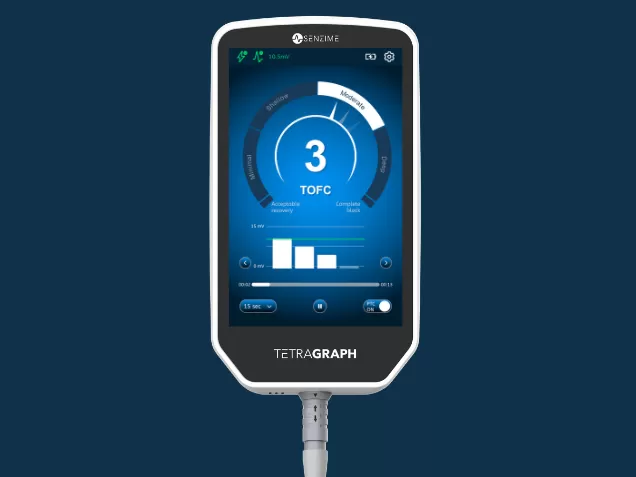The 2018 Enhanced Recovery After Surgery (ERAS) guidelines state that reversal of neuromuscular block to a TOF ratio of ≥0.9 is important to avoid residual paralysis.
Supported by clinical evidence
Quantitative train-of-four (TOF) monitoring helps to elevate patient care.
Clinical publications highlight that quantitative TOF monitoring significantly reduces the incidence of postoperative residual curarization (PORC), leading to fewer respiratory complications and enhanced patient safety. (1-2)
Quantitative TOF monitoring may help support improved recovery profiles, shorter hospital stays, and better overall outcomes, aligning with ERAS goals of faster recovery and reduced healthcare costs. (1-3)
Accurate TOF monitoring facilitates appropriate dosing of reversal agents,ensuring complete recovery from neuromuscular block minimizing the risk of residual paralysis. (4)

ERAS protocols emphasize the importance of minimizing postoperative complications and promoting faster recovery.
Quantitative TOF monitoring is a critical component, as it ensures adequate reversal of muscle relaxants, reducing the risk of residual neuromuscular block and associated respiratory complications.
TetraGraph is the first portable, clinically validated EMG-based quantitative neuromuscular monitor with accurate peak-to-trough analysis, designed to support Enhanced Recovery After Surgery (ERAS) protocols.
It provides continuous train-of-four (TOF) readings, enhancing muscle relaxant dosing, guiding neuromuscular block reversal, and confirming a TOF ratio >0.9 for safe extubation.

- Fast and easy operation
One-button start with an intuitive interface, allowing for seamless integration into busy anesthesia workflows. - Small and portable design
Compact and portable, fitting effortlessly into any clinical setting without compromising on performance. - Integrated connectivity
Compatible with multi-parameter monitors and Electric Health Records (EHR) to enhance patient data management. - Compliant with guidelines
Compliant with the American Society of Anesthesiologists (ASA) and the European Society of Anaesthesiology and Intensive Care (ESAIC) guidelines for neuromuscular monitoring, supporting best practices in perioperative care.
Our team of clinical specialists provides comprehensive support for successful implementation, protocolization, and continuous operation of TetraGraph.
Contact us for more information, learn how we can support your ERAS protocols, or to request a demo.
- APSF Newsletter. “Avoiding Postoperative Residual Weakness—A Cornerstone of Any ERAS Protocol.” October 2019.
- Gustafsson, U. O., et al. “Guidelines for Perioperative Care in Elective Colorectal Surgery: Enhanced Recovery After Surgery (ERAS) Society Recommendations.” World Journal of Surgery, 2019.
- Butterly A et al, Postoperative Residual Curarization from inter-mediate acting neuromuscular blocking agents delays recovery from discharge. BR J Aneast; 2010.
- Glenn S. Murphy, Sorin J. Brull; Quantitative Neuromuscular Monitoring and Postoperative Outcomes: A Narrative Review. Anesthesiology 2022; 136:345–361 doi: https://doi.org/10.1097/ALN.0000000000004044.
